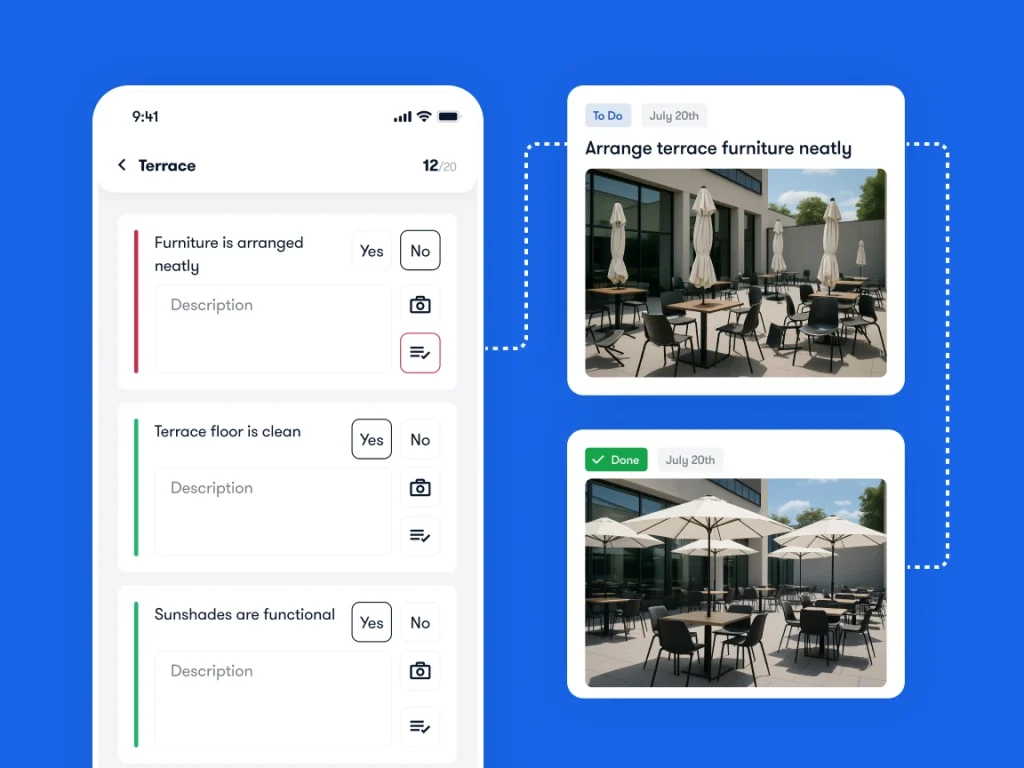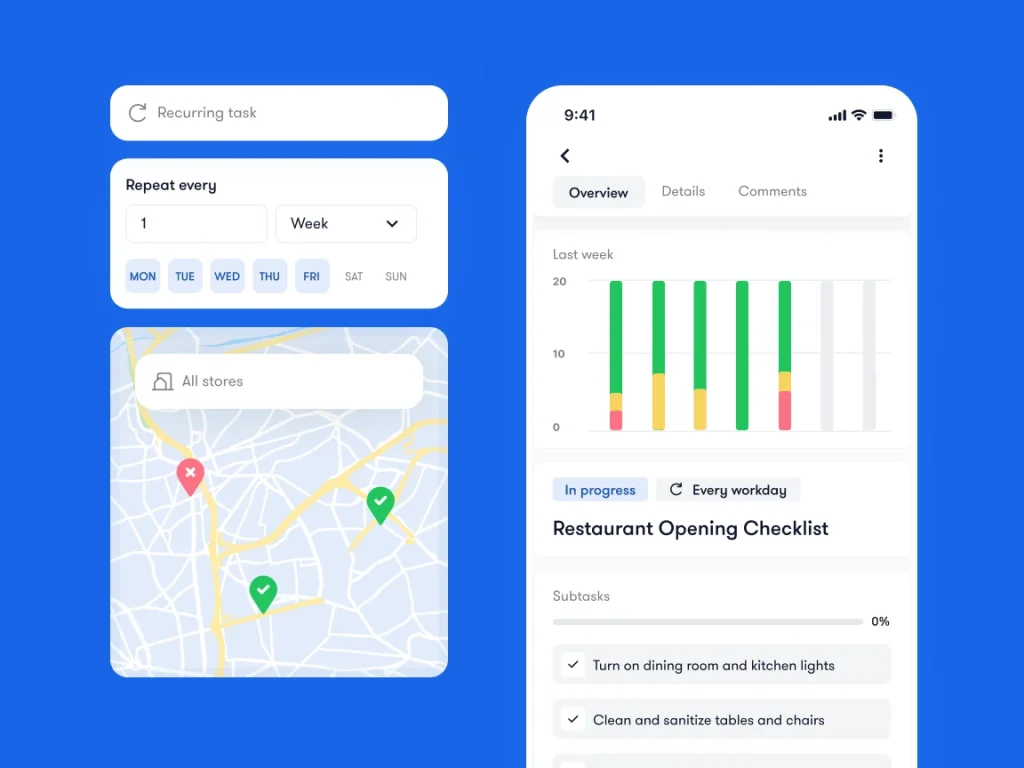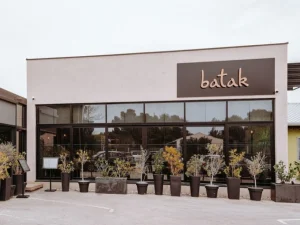If you’re in the restaurant business, you know that restaurant operations can get really messy. Between last-minute callouts, missing inventory, and a printer that decides to die during the lunchtime rush, it’s easy to feel like you’re always one step behind.
But here’s the good news – it doesn’t have to be that way.
Solid operations don’t just make life easier for managers. They lead to smoother shifts, faster service, fewer mistakes, and a team that’s actually in sync (not just trying to be). The best part? You don’t have to make complicated changes to get there.
In this post, we’re breaking down 7 simple, practical ways to improve your restaurant operations – starting with the stuff you can fix today.
Key takeaways:
Use checklists: Keep daily tasks clear, consistent, and digital.
Train properly: Structure onboarding and cross-train your team.
Streamline communication: Centralize updates and task tracking.
Track inventory often: Do regular checks and set smart alerts.
Listen to staff: Make it easy for your team to share feedback.
Automate tasks: Use tech for recurring chores and reminders.
Track performance: Use simple data to coach and improve.
1. Standardize Your Daily Checklists
Opening, closing, cleaning, prep – there’s a lot to remember every shift. And let’s be honest, if you’re relying only on your memory (or a scribbled list taped to the fridge) it’s highly likely that something important will be forgotten or missed.
Checklists keep everyone on the same page and help make sure the basics actually get done – every time, by everyone.
The key? Keep them clear, specific, and easy to access.
No vague tasks like “clean kitchen.” Be direct: “Sanitize prep tables,” “Restock line,” “Log fridge temps.”
And if you’re still using paper? It might be time to upgrade. With Bitreport, you can turn those paper checklists into real-time digital workflows. Assign tasks to roles, track if they were completed, and keep everyone on track, no micromanagement involved.

2. Train Like You Mean It
Are you one of those people who think throwing people into the fire is the best you can do for them? Or that the best way to learn something is exclusively by doing? That’s not training – that’s stress (for everyone).
Real training means having a structured onboarding process and clear SOPs (standard operating procedures). Not just “watch what they’re doing for a few shifts,” but actual guidance: here’s how we do things, here’s why it matters, and here’s what success looks like.
Also, training your staff to do more than just their main job (like teaching hosts to clear tables or servers to help in the kitchen) makes your team more flexible. So if it gets really busy, or if someone doesn’t show up, others can step in and help, and the shift can still run smoothly.
3. Streamline Communication
We’ve all seen it: missed messages in the group chat, forgotten hallway conversations, and five people saying, “Wait, no one told me that.”
If you want smoother operations, you need a clear and consistent system for communication. That means shift logs, internal notes, and a place to flag issues where they won’t get lost.
The best way is to use one tool where your team can share updates, track what needs to be done, and stay informed, without juggling a bunch of apps or trying to remember everything. When everyone knows what’s happening, the shift runs smoother. When they don’t… well, you already know how that goes.

4. Stay On Top of Inventory (Without Losing Your Mind)
Nothing derails a shift like running out of fries at 7 p.m. Or realizing you’re down to one lonely bottle of ketchup when your restaurant is packed.
The fix? Regular, lightweight inventory checks, not once-a-month marathons. Stay on top of your par levels, adjust them based on usage, and keep an eye on supplier performance (late deliveries add up fast).
Better yet, use tools like Bitreport to set reminders when inventory checks need to be done, so you’re not relying on sticky notes or memory.
5. Build a Feedback Loop with Your Staff
Your team is on the front lines every day, they see the problems before you do. So why not use this information?
Make it easy for staff to flag issues or suggest improvements, even anonymously if that helps them speak up. Maybe the prep list is out of order, or the POS flow makes no sense during a rush. You won’t know unless you ask.
Take time to review processes together, even briefly. What’s clunky? What’s confusing? What’s costing them time or energy?
Your team usually knows what’s broken. The trick is giving them a voice and actually listening.

6. Automate the Repetitive Stuff
There’s no glory in remembering to clean the grease trap or refill the soap dispenser, but those little things add up fast when they’re missed.
That’s where automation comes in. Set up automated workflows through tools like Bitreport for things like cleaning schedules, maintenance checks, and daily open/close routines. Add reminders, assign responsibilities, and let the system keep track, not your brain.
You don’t need to micromanage when the tools are doing the nudging for you.
And most importantly: the more you automate, the more time (and headspace) you free up for what matters: running smooth shifts and creating a great guest experience.

7. Make Performance Visible (But Not Scary)
You can’t fix what you can’t see. Start tracking basic operational metrics: things like task completion rates, late openings, or recurring shift issues. Nothing fancy, just a clear picture of what’s working and what’s slipping.
And here’s the key: use the data to coach, not punish. This isn’t about exposing mistakes, it’s about spotting patterns, giving support, and making improvements together.
Don’t forget to highlight what’s going well, too. A little recognition goes a long way.
When the team knows what success looks like (and sees their impact), everything runs better.
Conclusion: Better Ops = Better Everything
Improving your restaurant’s operations doesn’t mean flipping everything upside down. Start small: pick one area, make a tweak, see what changes. Then keep building from there.
With the right tools and a bit of consistency, you can run a shift that’s smoother, smarter, and way less stressful, for you and your team.
Ready to ditch paper checklists and start tracking tasks in real time? Bitreport can help you get there, without the headache.





